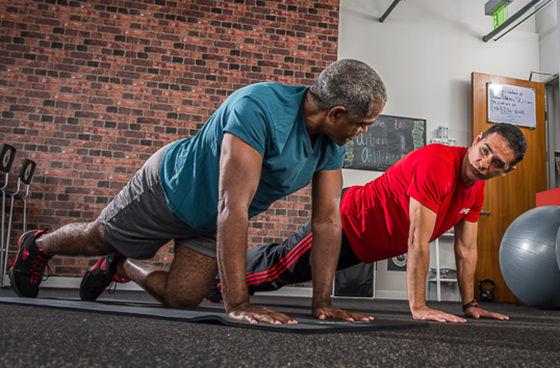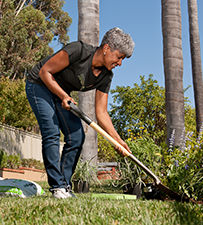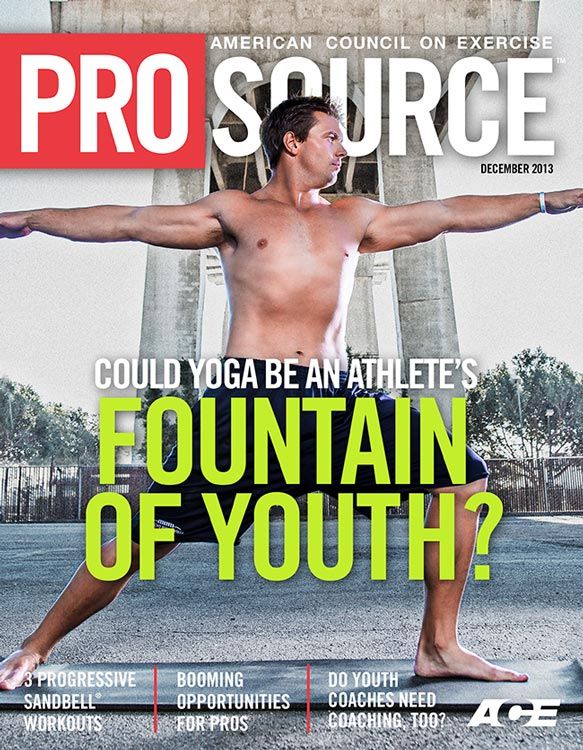
“I never thought I’d be able to do that again, let alone do it with ease!”
That’s what one of my 80-year-old female clients proudly announced after she painted her porch one weekend. I’ve received many similar stories from my senior clients, who realize that exercise provides benefits far beyond weight loss.
“The main fitness goal for all seniors, from frail to active, is function,” says Mary Ann Wilson, an ACE-certified Fitness Professional and executive director, producer and host of the Sit and Be Fit television series. “The focus of each workout should include exercises that will maintain and/or improve the client’s physical ability to perform the activities of daily living adequately. The goal is to live independently to one’s last breath and that requires a certain level of physical and mental fitness.”

Simple tasks younger folk may take for granted can become obstacles to seniors living independently and maintaining a healthy quality of life. Sitting and standing without assistance, confidently going up and down stairs, and being able to get up off the floor are all skills that can be lost if muscles atrophy and certain fitness components, such as balance and coordination, have decreased.
“Although ‘functional exercise’ is a trend in the fitness world right now and is performed by all ages, it is the senior population that functional exercise was originally created for,” explains Scott A. Weiss, D.P.T., A.T.C., C.S.C.S., co-founder and owner of Bodhizone Physical Therapy in New York. “And it is the senior population that needs this as the focus of their exercise prescription. As we age, we have a decreased ability to do simple everyday tasks. By training the mechanics or parts of the movement in the activities of daily living, it creates a workout in which seniors accomplish tasks with greater ease and vigor throughout their life. Life-applicable exercise is the key to this population.”
There’s an App for That!
One thing you must take into consideration when working with the senior population is medication, because most of your clients will likely be taking one or more prescriptions or over-the-counter meds. As trainers, there are two things you need to know about medications, explains Weiss. “First, learn how these medications affect exercise—easier to fatigue, increased chance of muscle tears, balance issues or cramping, etc. And secondly, question the interaction of medications. Although most physicians have this area covered as it is their jurisdiction, from experience, I’ve realized that exercise can trigger many symptoms.”
There are several phone apps you can use that will help you understand drug interactions.

MEDSCAPE

EPOCRATES

DAVIS'S DRUG GUIDE
To learn more about out how a specific medication may affect exercise response, refer to this article in the June 2013 issue of ACE Certified News.
Wilson agrees. “There are three areas in the realm of functional fitness that I think are extremely important and specific to the senior population. Sit-to-stand and stand-to-sit exercises, progressive exercises to learn how to get down and up from the floor, and increased awareness of the pelvic floor and exercises to strengthen those specific muscles are essential for older adults.”
Weiss adds that all components of fitness—cardiovascular exercise, resistance training, flexibility and balance exercises—are just as important for the senior population as they are for younger groups. Colin Milner, CEO of the International Council on Active Aging (ICAA) in Vancouver, British Columbia, states that you must also take various components of an older adult’s life into consideration.
“One could say seniors wish to remain independent, reduce the impact of chronic disease, and improve their functional abilities to lead a quality life,” explains Milner. “This would be the easy answer. However, a lifetime of diverse experiences, and the behaviors they have created, makes the older adult an extremely unique segment of the population. These experiences and behaviors impact everything, from where and how people live, to their health status and quality of life.”
Milner goes on to say that meeting this group’s expectations and needs requires you to understand who they are. “Consider, for example, their physical and cognitive abilities, health, work or marital status, sex, sexual orientation, race and culture, as well as whether or not they have children or grandchildren, access to transportation, and disposable income. This is why the older-adult market will challenge [fitness professionals’] creativity, strategic thinking, planning and implementation processes, and why one-size-fits-all solutions fail miserably with these individuals. To address this group, you will first need to establish this group’s wants and needs. Once you do so, think about what kinds of workouts you can create and deliver to meet the expectations of this large, diverse market.”
Senior Intimidation
Have you ever worked with older adults? It is both a unique and rewarding experience, for many reasons.
“You will not find a more appreciative group of participants,” says Wilson. “They are charming and have so much wisdom to share with you. What I love most about teaching seniors is to watch their confidence grow in themselves and the delight in their eyes when they accomplish something they initially found difficult. Helping to overcome hurdles they once saw as barriers and being successful in their attempts to achieve good health is the greatest blessing any fitness pro could ask for.”
“After working with many seniors and the aged I have come to realize the wisdom of this generation,” says Weiss. “Most tend to see the bigger perspective on life situations and easily know how not to sweat the small stuff. Sometimes I learn more from my clients than they do from me. Connecting with people of age and wisdom may develop the confidence to talk with anyone while picking up pearls of life!”
“The reality is you have clients with great human potential, just as you do with an athlete or younger person,” explains Milner. “It is then up to you, the trainer, to help tap that potential. Don’t coddle them. Train them according to their abilities and the guidelines and you will see amazing results.”
“It’s sexy to work with athletes or those who are fitness fanatics, but the reality is that in three years 50 percent of the population will be over 50. They have 47 times more savings than the young and they account for 70 percent of discretionary income. The results you help them achieve could change their lives, keeping them coming back for more.”
By passing up the opportunity to work with the senior population, you may be waiving potential income and dedicated long-term clients. “The fitness industry has been a youth-driven industry,” adds Milner. “It’s sexy to work with athletes or those who are fitness fanatics, but the reality is that in three years 50 percent of the population will be over 50. They have 47 times more savings than the young and they account for 70 percent of discretionary income. The results you help them achieve could change their lives, keeping them coming back for more.”
Want to be more comfortable working with the senior population? The ACE Senior Fitness Specialty Certification will help you connect with the senior set, and learn modifications and progressions to help them prevent muscle deterioration, improve balance and bone strength, and boost quality of life. The course includes books, online content and quizzes, and DVDs that include specifics on exercise, communication, nutrition, and information on common diseases and conditions.
“If you are in the business of getting and keeping people fit, the older adult market is the market,” exclaims Milner. “The question to ask is, ‘Why do I not want to grow my business with those who need it and can afford it?’ You will find the answer lies within our ageist perceptions. Change this and you change your future!”





 by
by 






